Module 8: Lesson 4
Self-Check 2
- Questions 3.b., 11.c., 12.a., 12.b., 17.a., and 17.d. on pages 542 to 543
-
- This is the 4th term in row 7 of Pascal’s triangle, which means that it will be equivalent to 6C3 or

- This is the 4th term in row 7 of Pascal’s triangle, which means that it will be equivalent to 6C3 or
-
- You will probably use a method such as guess and test to solve this question. By using this method, you should notice that the value of r that gives the maximum value occurs when r = 6. The value for 12C6 is 924.
-
- By looking at the expansion, you can see the following for the binomial (a + b)n:
n = 4
a = x
b = y
Thus, this expansion is equivalent to (x + y)4. - By looking at the expansion, you can see the following for the binomial (a + b)n:
n = 5
a = 1
b = −y
Thus, this expansion is equivalent to (1 − y)5.
- By looking at the expansion, you can see the following for the binomial (a + b)n:
-
- The following information is necessary to solve this question:
n = 3
k = 0 or 1 or 2 or 3 (depending on which term is being solved for)

y = 2
The solution for the first four terms (all of the terms) is as follows:
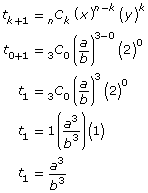
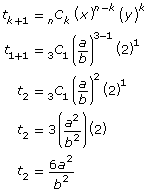

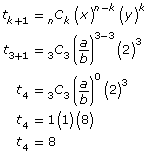
Thus, the expansion of the first four terms is
- Before solving this question, it may be easier to arrange it so that there are no fractions.

The following information is necessary:
n = 4
k = 0 or 1 or 2 or 3 or 4 (depending on which term is being solved for)
x = 2x2
y = −x−1
The solution for the first five terms (which is all of the terms) is as follows:
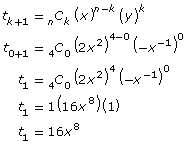

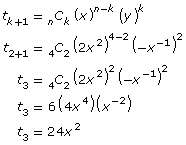
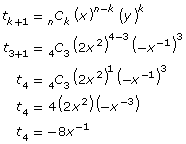
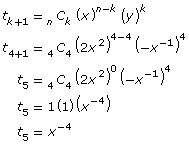
Thus, the expansion of the first five terms is 16x8 − 32x5 + 24x2 − 8x−1 + x−4 or

- The following information is necessary to solve this question:
-
© 2012 Alberta Education